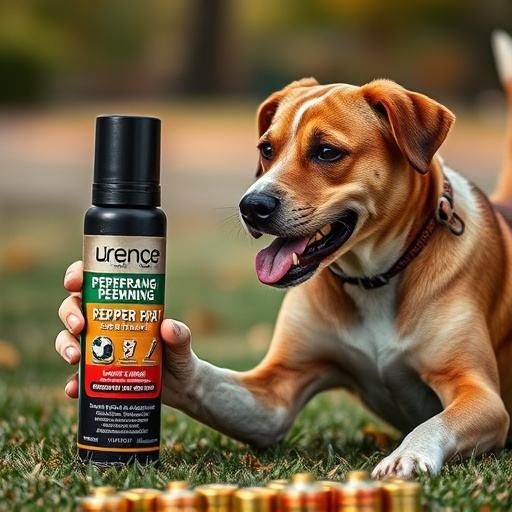Dog deterrent sprays using capsaicin and citrus oils curb barking and aggression with proper technique. Choose certified products, understand range/strength, practice motion-activated dispensing, test regularly, and know local laws. Master calm deployment at face level, start with light misting, target eyes/nostrils, time usage as a last resort. Train dogs using positive reinforcement, commands, gradually introduce spray linked to commands for effective behavior modification.
“Unraveling the secrets of effective dog deterrence, this comprehensive guide delves into the best formula for dog deterrent spray. Understanding the active ingredients and prioritizing safety is paramount. We’ll navigate factors like scent strength and application methods to choose the ideal spray for your needs. Learn how to use these tools effectively with practical mace spray techniques and training strategies for consistent behavior modification. Maximize deterrence while ensuring animal welfare.”
- Understanding Dog Deterrent Sprays: Active Ingredients & Safety
- Choosing the Right Spray: Factors to Consider for Effective Deterrence
- Application Techniques: How & When to Use Dog Deterrent Spray
- Training and Consistency: Enhancing Spray Efficacy through Behavioral Modification
Understanding Dog Deterrent Sprays: Active Ingredients & Safety
Dog deterrent sprays are designed to discourage unwanted canine behavior, such as barking or aggression, by using specific active ingredients that trigger a sensory response in dogs. When choosing a formula, understanding the composition is key. Common active ingredients include capsaicin, a compound found in chili peppers, and synthetic citrus oils, which have a strong odor that can repel dogs without causing them harm. These natural components are generally safe when used correctly, but it’s essential to follow application guidelines strictly.
Safety is paramount when using any deterrent spray. Pet owners should opt for products certified by reputable organizations and check the label for instructions on usage and frequency. How to practice mace spray techniques involves aiming accurately, allowing a short burst of the spray to land in front of the dog, not directly at it, as this can cause inhalation issues. Regular practice ensures the method is effective yet humane, addressing unwanted behaviors without causing stress or injury to your pet or others.
Choosing the Right Spray: Factors to Consider for Effective Deterrence
Choosing the right dog deterrent spray involves understanding several key factors for effective deterrence. First, consider the active ingredients in the formula; capsaicin, a component found in chili peppers, is commonly used and safe for both pets and humans. It triggers a mild irritation that disrupts an animal’s behavior without causing serious harm. Additionally, always check the spray’s range and strength; a shorter range might be sufficient for smaller areas, while stronger solutions are better for larger spaces or more persistent intruders.
The method of application is another crucial aspect when learning how to practice mace spray techniques. For dog deterrents, consider using motion-activated dispensers that release the spray upon detection, which can be highly effective in deterring dogs from specific areas. Regularly testing and refilling the spray is essential to maintain its potency. Moreover, understanding local laws regarding the use of such sprays is vital to ensure compliance and responsible usage.
Application Techniques: How & When to Use Dog Deterrent Spray
Effective dog deterrent spray usage involves understanding and practicing specific mace spray techniques. The ideal time to deploy the spray is when a dog shows signs of aggression or invades your personal space. Approach the dog calmly, ensuring your safety first. Aim for the face and muzzle area, as this is highly sensitive. Start with a light misting to discourage the dog without causing panic. If the dog persists, follow up with a stronger burst directed at its eyes and nostrils. Practice these mace spray techniques regularly to ensure you remain composed under pressure.
Remember, timing is crucial; using the spray as a last resort can be counterproductive. Keep the spray readily available and familiarize yourself with local laws regarding its use. By mastering these application techniques, you’ll enhance your ability to protect yourself from potentially dangerous dog encounters.
Training and Consistency: Enhancing Spray Efficacy through Behavioral Modification
Training and consistency are key factors in enhancing the efficacy of dog deterrent spray, also known as mace spray. When used appropriately, this method can be a powerful tool for modifying canine behavior. The first step is to understand that positive reinforcement is far more effective than punishment when it comes to training dogs. Reward good behavior with treats or praise immediately after the desired action is performed. This reinforces in the dog’s mind that certain behaviors lead to positive outcomes.
For mace spray techniques, practice is essential. Teach your dog basic commands like “sit,” “stay,” and “come” consistently using verbal cues and hand gestures. During training sessions, introduce the spray gradually, starting with a mild misting while the dog is calm. Gradually increase the intensity as needed, always ensuring that the dog associates the spray with the command you’ve given. Consistency in both training methods and environmental conditions will help your dog learn and respond positively to the deterrent spray over time.
Dog deterrent spray, when used correctly, can be an effective tool for managing unwanted canine behavior. By understanding the active ingredients, choosing the right formula, and employing precise application techniques, you can create a safe and humane environment that discourages your dog from unwanted actions. Combining these methods with positive reinforcement training strengthens behavioral modification, ensuring long-lasting results. Remember, consistent practice of mace spray techniques is key to successful deterrence.
